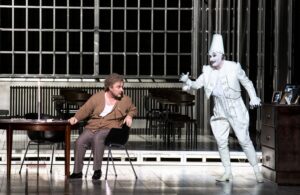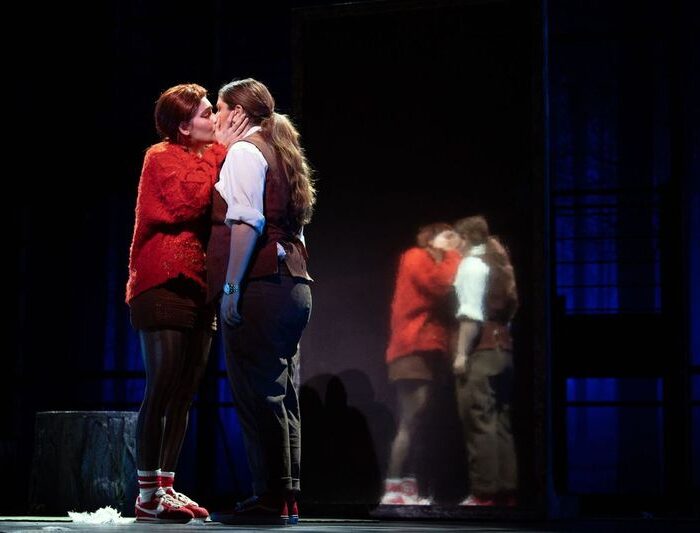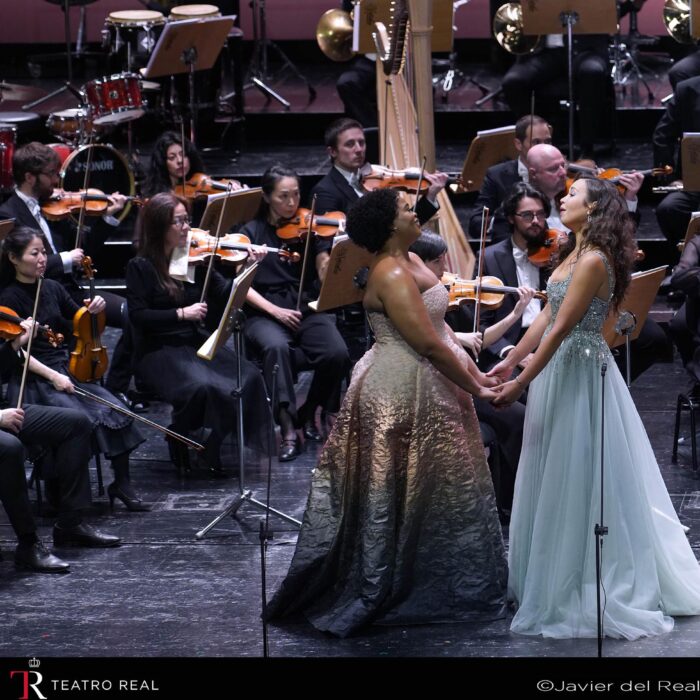
Opera de Paris 2022-23 Review: Hamlet
By Mauricio VillaPhoto: Bernd-Uhlig-OnP
On Mar. 11, 2023, Paris Opera premiered a new production of Thomas’s “Hamlet” at the giant opera colosseum, La Bastille. “Hamlet” premiered at Paris Opera, then known as Académie Impériale de Musique, in 1868, with immense success. One year later, the opera was presented in London with an alternative ending where the hero, Hamlet, dies, changing Shakespeare’s original ending, in which Hamlet is coronated king. It was quickly presented in New York, Vienna, and Berlín. But, in the 20th century, the opera disappeared from the repertoire and was delegated to a few spare productions. France has always kept French grand opera present by performing forgotten titles like “Lakme,” “Robert le Diable,” or “Hamlet.” However, this new production at the Bastille was a great event. The opera has not been performed at Paris Opera for quite a long time, and the cast was stellar.
A Real Tragedy
Krzysztof Warlikowski directed the new production. The Polish director is famous for his renovation of the theatre language in Europe and his adaptations of the big tragedies of Shakespeare and Greek theatre. But does his approach and concept work in staging an opera? It doesn’t. While watching Warlikowski’s work, I couldn’t understand “Hamlet’s” plot at all.
The set was a big cage reminiscent of a prison or an asylum. In the overture, we saw a very old Hamlet. With the characterization and great interpretation of Ludovic Tézier, it was very difficult to identify the character until he started singing, with some degree of dementia. meanwhile, there was a very old woman in a wheelchair, watching a black-and-white movie. This was Gertrudis. And seated around a table were Ophelie, Laertes, and Claudius playing poker.
At some point during Act one, the action was back in time when Hamlet and his mother were younger. The leap of time wasn’t understandable at all. The ghost of Hamlet’s father was a circus clown all in white. Hamlet and his mother end up in bed after their big confrontation in Act three. And during some ballet scenes–which are usually cut–the whole choir was dressed up in female ballet dancer costumes and made ballet figures and steps, which looked grotesque.
Ophelie, wearing sparkling brilliantine high heels and an impossibly fake blond wig, distributed oranges during her “mad scene.” But one wouldn’t see any madness at all. She was then lifted up in the air and turned around by a dancer during her coloratura sections. Which may have been quite a challenge for Lisette Oropesa.
The final act went back to the frame of the beginning, except with Hamlet in white clown make-up and black clown costume. There was an urn of ashes while Ophelie was walking around the stage in her funeral scene, which could have meant that she didn’t know she was dead. Projections, big open spaces… It was nonsense in general, and difficult to understand what Warlikowski’s point of view on the opera was.
Ludovic Tezier’s Brilliant Hamlet
Hamlet is the absolute protagonist of the opera. It’s a very long role with four arias, three duos, and several ensemble scenes. And for once, it is delegated to a baritone. It is probably the only baritone role in opera where the vocalist performs the young hero and not the father or the villain. The role requires a high lyrical voice, which should freely move throughout the whole register, emit easy floating high notes, expansive fraseo, legato singing, and uncommon stamina.
The French baritone Ludovic Tezier accomplished the demands of the part brilliantly. His French diction and fraseo were impeccable. He could sing in a high tessitura, like in the duet with Opehlie: “Ah! Doute de la lùmiere” constantly singing between E flat and F, and following the written dynamics in every extent of his tessitura. He managed to keep his voice fresh after a long night of singing and was able to do two astonishing diminuendo in two high F sharps, as he had already done in the trio in Act three in the line “Aux soupirs d’amour,” twice.
Tezier sounded heroic and bombastic for the “wine song” in Act two, delivering a secure and easy high G, and at the same time, was menacing and aggressive for the duet with his mother in Act two. It was incredible how he can sing Scarpia and heavy Verdi roles and still color and lighten his voice to sound young. He showed all his vocal potential on the F sharp of ”Vaine couronne, à bas” and the high G in ”O liqueur, ah, ah!” with strong, resonant, and secure high notes. He sang with thrilling pathos and whispered mezza voce during his aria,” Être ou ne pas être…” Hamlet is usually sung by high lyrical baritones and not strong projected voices like Tezier’s. His characterization was amazing too. He was emotional, strong, and believable, and he delivered the big dramatic arc that Hamlet goes through throughout the opera.
Lisette Oropesa
The lirico-leggera soprano Lisette Oropesa portrayed Ophelie. Her velvety dark timbre suited a score which is mostly written in the middle of the voice, and her depurated technique enabled her to sing the octave interval from central to high B flat with sweetness and delicacy in the Act two aria “Adieu dit-il,ayez foi.” But, at the same time, her several ascensions to high notes were secure, brilliant, and projected. These included several B naturals in the cabaletta of the second act aria, a high C in the first act duet, and a C sharp in the already mentioned cabaletta.
But it was the “mad scene” the audience was waiting for, and Oropesa didn’t disappoint at all. She sang clean scales delivering sparkling B naturals and C sharps, maintained her strong center secure for the ballad section, and fast depurated coloratura for the Waltz sections. The qualities of her voice matched the strange and demanding vocal writing of this long scene which required singing fast and high, slow and central, crazy coloratura, and a secure high register for the last section when the tessitura becomes really high. I can’t say much about her acting as I didn’t understand what was going on in this scene, but she did what she was asked with determination, finishing the scene with a soaring pianissimo high B natural as she disappeared inside a bathtub.
Ève-Maud Hubeaux
The mezzo soprano Ève-Maud Hubeaux sang the role of Gertrude. She has a lyrical bright high mezzo-soprano voice, but she managed to use an immense palette of vocal colors to sound authoritarian, majestic, inquisitive, begging, and sorrowful much at the same time. The role is very well written as the tessitura keeps increasing gradually through the night, giving the singer the chance to warm up the voice on the stage. She sang her lamenting aria from Act two, “Dans son regard plus sombre,” with fluid long legato lines and with even timbre and projection from the low C’s to the high A flats.
Her voice was present and resonant in the final concertante of Act two. But, it was in her confrontation duet with Hamlet in Act three that she could show the extension and power of her voice. She managed to sound hysterical and frightened without sounding strident, and therefore delivered a strong forte, maintained high A natural in ”Grace! Epargne moi!” and finished the line in a strong chest voice low D. She could effortlessly rise up in forte to high B flat in “Hélas! Hélas! Se trainer en pleurant!” and sang dramatically but controlled through the end of the line, which demands phrasing in forte constantly between F and G flat (an uncomfortable tessitura for a mezzo-soprano). She finished the long dramatic scene with a secure ringing high B flat in “d’épouvante et d’horreur!”
More Highlights
Clive Bayley was very convincing in the short but dramatically important role of “the specter of the king.” His interventions were very short, and the tessitura was very comfortable, but he could prove his acting skills and his big and round resonant voice.
Jean Teitgen was a lyrical Claudius, singing a beautiful Act three aria, “Je t’implore,ô mon frere,” with long expansive lines and expressive crescendos/diminuendos. He seemed more secure in the high register as he sang a strong high F on the line, “Apaise la colére,” but chose the option of finishing the aria on the optional central E flat rather than in a low E flat.
The tenor Julien Behr sang the small role of Laertes. The role is very short, with a small aria and a few spare lines, with a central tessitura, although it moves around the passagio zone quite often and with soft orchestration. Behr sang with exquisite mezza voce and legato lines during his aria, “Pour mon pays.” Though it seemed strange that he decided not to sing the optional B flat, as it is the single high note within the role.
The French conductor Pierre Dumoussaud knew how to defend Thomas’s score and exploit the best out of it. Thomas’s score is quite irregular. Although it has some bombastic cliché scenes which the “Grand Opera imposed,” there was a clever use of the leitmotivs and dense orchestration, like the “invocation scene” or the duet between Hamlet and his mother. Dumoussaud managed to create big bombastic brilliant moments like the opening coronation scene, the “wine aria,” or the second act concertante but created a big contrast with intimate moments full of tension like the apparition of the ghost, Hamlet’s arias, or the death of Ophelie.
Baffling was the crazy modern and asonant improvisation that the saxophonist performed during his solo in the pantomime scene; it was completely out of style.
It was strange to cut completely the choir, “Nargue de la tristesse,” which created an odd change in the melody and the harmony. But, at the same time, he included the full choir and some ballet numbers in Act four, which are usually excised. The tendency today is to have more musical rigor and, therefore, it would have been more adequate to present the whole score uncut.
The Orchestre and Chorus of l’Opera national de Paris were brilliant in a repertoire that they knew very well.
Paris Opera’s show was another conceptual modern production of the mostly unknown opera “Hamlet,” which had a strong cast of singers, with the standout being Ludovic Tézier for his vocal and dramatic characterization of such a long and hard role.


